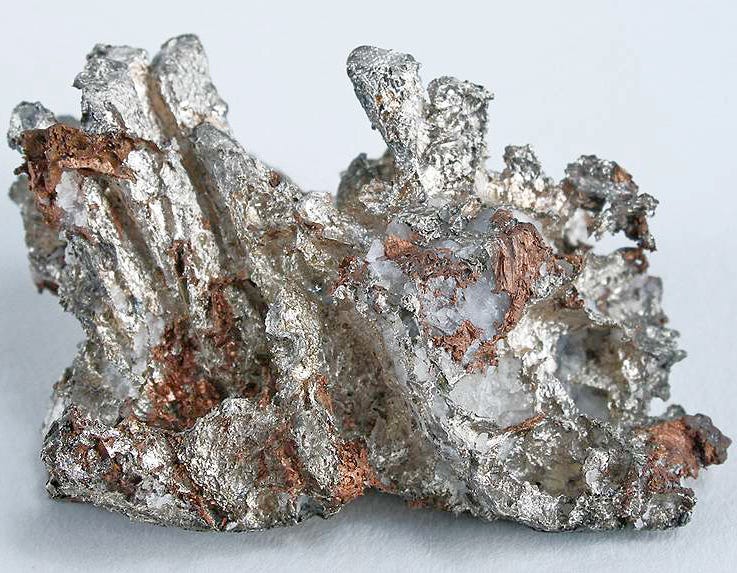Bayhorse Silver (and Copper)
Bayhorse Silver put out a press release with the assays from its underground, short hole, drilling program.
Headline numbers:
DDH BDD104
0.3 m (1 ft) of 34.28 oz/t (1066 g/t) silver and 1.85% copper.
0.6 m (2 ft) of 11.34 oz/t (352.7 g/t) silver and 1.15% copper.
0.6 m (2 ft) of 6.92 oz/t (215.2 g/t) silver and 0.334% copper.
0.6 m (2 ft) of 5.75 oz/t (178.8 g/t) silver and 0.344 copper.DDH BDD105
0.6m (2ft) of 12.72 oz/t (396 g/t) silver and 0.876% copper.
0.6m (2ft) of 5.95 oz/t 1(85 g/t) silver and 0.2% copper.DDH BDD103
0.6 m (2ft) of 6.27oz/t (195 g/t) silver and 0.22% copper
BHS (BHS.V) also reported face samples taken from the south wall of the Big Dog bypass decline:
192.35 oz/t (5,984.72 g/t) silver and 10.7 per cent copper;
50.88 oz/t (1,582.54 g/t) silver and 4.51 per cent copper;
3.3 oz/t (102.64 g/t) silver and 1.72 per cent copper.
The usual caveats apply to face samples, essentially they are the “shiniest” rocks a geo or miner sees and are not representative of the overall deposit; but they are very suggestive.
This drilling took place in an entirely undrilled section of the Bayhorse mine which has become safely accessible due to the construction of the Big Dog bypass decline. The silver values are excellent but, frankly, not a surprise. It is, after all, a silver mine.
The copper results, even in the short intervals, are intriguing. The excitement along the Izee/Olds Ferry terrane sutures is all about copper. Hercules (BIG.V) at Mt. Cuddy, 75 kilometers to the northeast of the Bayhorse mine, kicked it off back in October of 2023 with a long hole which hit what BIG hopes is a copper porphyry. Much geological theorizing ensued and a staking race ran from north of Mt. Cuddy all the way through the aptly named “Mineral” to within a couple of miles of the Bayhorse mine. Mainly Barrick but several other companies staked Izee positions.
Riding the coattails of BIG, BHS CEO Graeme O’Neill raised 1 million dollars by way of private placement and quickly organized a VTEM survey of the land around the BHS mine and land across the Snake River in Idaho. It dispatched its billy goat to stake the ground the VTEM suggested might be prospective. Critically, Bayhorse was not flying blind. Quite the opposite, really.
Bayhorse has had the counsel of Ph.D geos all the way along its journey. One of them, Dr. Clay Conway, mapped what the company believes is an extension of the Bayhorse mine rhyolite on the Idaho side of the Snake River. There is every reason to believe it will share the geological characteristics disclosed at the Bayhorse mine. It might well be a silver mine in itself in the mining-friendly jurisdiction of Idaho.
One of those characteristics, which today’s release confirmed, is that while there is high grade silver there is also a meaningful copper endowment. The concentrate BHS produced a couple of years ago, ran almost 10% copper.
Until the BIG discovery, Bayhorse was primarily interested in re-opening and permitting the Bayhorse silver mine. The company saw itself as silver-focused and, as importantly, as a mine developer rather than an exploration company. Which meant the copper content of the concentrate and the drill cores taken from the underground drilling at the mine were never examined very closely. In fact, BHS put out a number of press releases over the years which referred to “Silver/Copper” but which only gave assay values for the silver.
On the Idaho side, Bayhorse’s Pegasus Project is looking for the same sorts of porphyries as BIG is hunting at Mt Cuddy. These are “blind” targets with no surface expression, but the huge advantage BHS enjoys is that it has an actual mine with clear, good grade, copper showings in a similar geological setting.
The old axiom that you “only find what you are looking for” applies to copper at the Bayhorse mine. Today’s release tells BHS and other interested parties that the Bayhorse rhyolite structure, while it is primarily a silver target, contains a significant copper endowment. Will that extend across into Idaho? And what does it mean in the context of the great porphyry hunt?
The Pegasus Project will look for answers to those questions. But for Pegasus to fly it is going to need money. Lots of it as the terrain likely means that drilling at Pegasus will have to be helicopter-supported. O’Neill has run helicopter drill programs before, notably in his native New Zealand, and he is well aware of the logistical challenges and costs.
I am looking forward to an announcement going to the funding of the Pegasus Project. There are a number of companies which have been staking ground on the Izee and investing a few million to access a drill ready, highly prospective, parcel of land might make a lot of sense.
[Disclosure: Graeme O’Neill is a friend. I own shares in Bayhorse Silver (BHS.V), a lot of shares, and may buy more or sell some or all at any time. I also have a position in BIG. This is not investment advice. Do your own due diligence. Call the CEOs. ]



